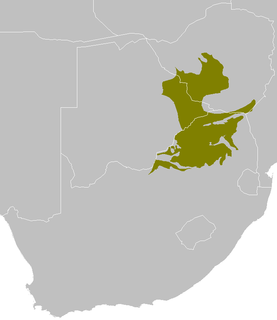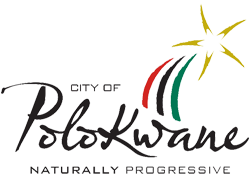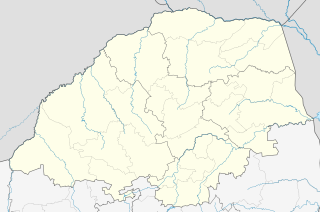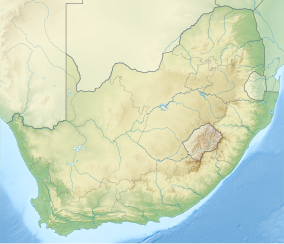The protected areas of South Africa include national parks and marine protected areas managed by the national government, public nature reserves managed by provincial and local governments, and private nature reserves managed by private landowners. Most protected areas are intended for the conservation of flora and fauna. National parks are maintained by South African National Parks (SANParks). A number of national parks have been incorporated in transfrontier conservation areas.

The Bushveld is a sub-tropical woodland ecoregion of Southern Africa named after the term veld. It encompasses most of Limpopo Province and a small part of the North West Province of South Africa, the Central and North-East Districts of Botswana and the Matabeleland South and part of the Matabeleland North provinces of Zimbabwe. Kruger National Park in South Africa has a number of 'Bushveld' camps.

The Peter Mokaba Stadium is a football and rugby union stadium in Polokwane, South Africa, that was used for the 2010 FIFA World Cup. It has a capacity of 45,500 but for the purposes of the 2010 FIFA World Cup the seating capacity was reduced to 41,733. It is named after Peter Mokaba, a former leader of the ANC Youth League. It is located 3 kilometers from the city center and is located just east of the older Peter Mokaba Stadium.

Polokwane City FC is a South African football club based in the city of Polokwane, Limpopo that currently plays in the Premier Soccer League.
Mapidima "Bally" Smart is a South African footballer, who last played as a winger or striker for Skonto Riga in the Latvian Higher League. Smart owns Polokwane United FC in the SAFA Second Division.

The Polokwane Local Municipality is a local municipality located within the Capricorn District in the Limpopo Province of South Africa. It shares its name with the city of Polokwane.
Júlio César Leal Junior is an association football manager.

Zebediela is a group of villages in Capricorn District Municipality of Limpopo Province, South Africa. It is situated south-east of Polokwane next to Lebowakgomo. It is well known for the production of citrus fruits. It is named after Sibitiela, a Ndebele chief of the area.

The 2014 African Nations Championship was the third African Nations Championship football tournament. The 16 national teams featured players from the respective national championships. The tournament took place between 11 January and 1 February 2014 in South Africa. Originally, the tournament was to be hosted in Libya. This was the first African Nations Championship tournament where all matches were considered full international matches.
102 Squadron is a reserve squadron of the South African Air Force. The squadron area of responsibility is from north of Polokwane (Pietersburg) to the Limpopo River and is used for reconnaissance flights along the South African and Zimbabwe and Botswana borders. The squadron is based at AFB Makhado. These reserve squadrons are used to fill a pilot and aircraft gap within the SAAF by making use of civilian pilots and their privately owned aircraft. Most flying takes place over weekends and because pilots have a good knowledge of the local terrain in the area where they live and commonly fly, the squadron is used mostly in the reconnaissance and crime prevention role.
Nedbank Cup is a South African club football (soccer) tournament. The knockout tournament, based on the English FA Cup format, was one of a weak opponent facing a stronger one. The competition was sponsored by ABSA until 2007, after which Nedbank took over sponsorship.
The Bokoni mine is a large open pit mine located in the north-eastern part of South Africa in Polokwane, Limpopo. Bokoni represents one of the largest platinum reserves in South Africa having estimated reserves of 75.7 million troy ounces (2,350 t) of platinum. The mine produces around 55,000 troy ounces (1,700 kg) of platinum/year.
The Modjadjiskloof Oval is a cricket ground in Modjadjiskloof, a small town situated at the foot of the escarpment in the Limpopo province of South Africa. Prior to 2004, this town was named Duiwelskloof.

Regiment Christiaan Beyers is an infantry regiment of the South African Army. As a reserve unit, it has a status roughly equivalent to that of a British Army Reserve or United States Army National Guard unit. The Regiment was named after General Christian Frederick Beyers, a Boer general during the Second Boer War.
The IPSC African Handgun Championship is an IPSC level 4 championship hosted every third year in Africa.
The Nedbank Cup is a South African club football (soccer) tournament. The knockout tournament, based on the English FA Cup format, was one of a weak opponent facing a stronger one. The competition was sponsored by ABSA until 2007, after which Nedbank took over sponsorship.

Ga-Ramokadikadi is an affluent, large village in Ga-Matlala in the Aganang Local Municipality of the Capricorn District Municipality of the Limpopo province of South Africa. It lies about 2 km south of Tibane and 54 km northwest of Polokwane on the Matlala Road.
The 2018 COSAFA Cup is the 18th edition of the COSAFA Cup, an international football competition consisting of national teams of member nations of the Council of Southern Africa Football Associations (COSAFA). In July 2017, it was reported that it would be hosted by Botswana in July 2018. However, in February 2018, COSAFA announced that South Africa would host the competition.










